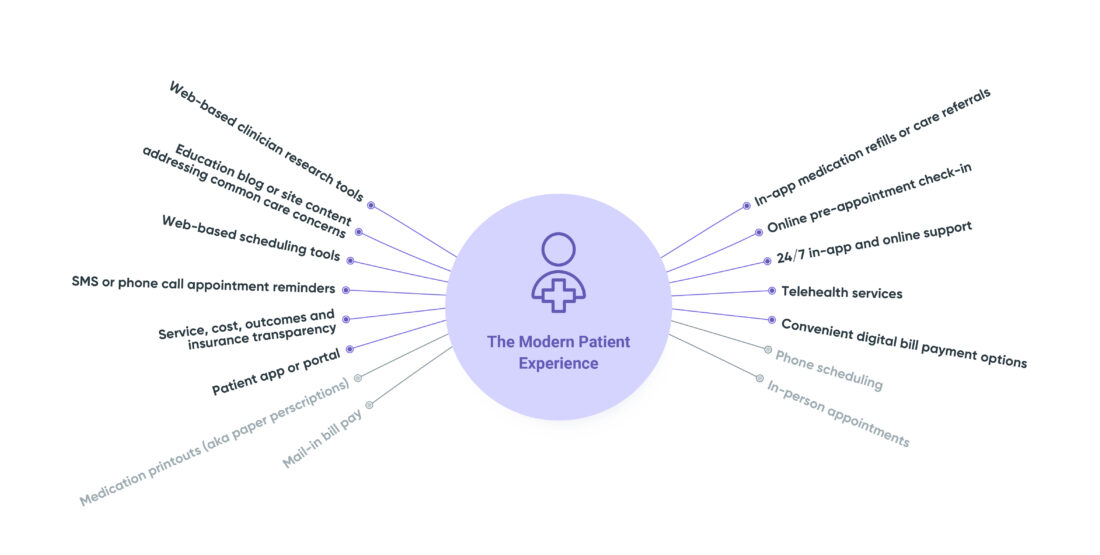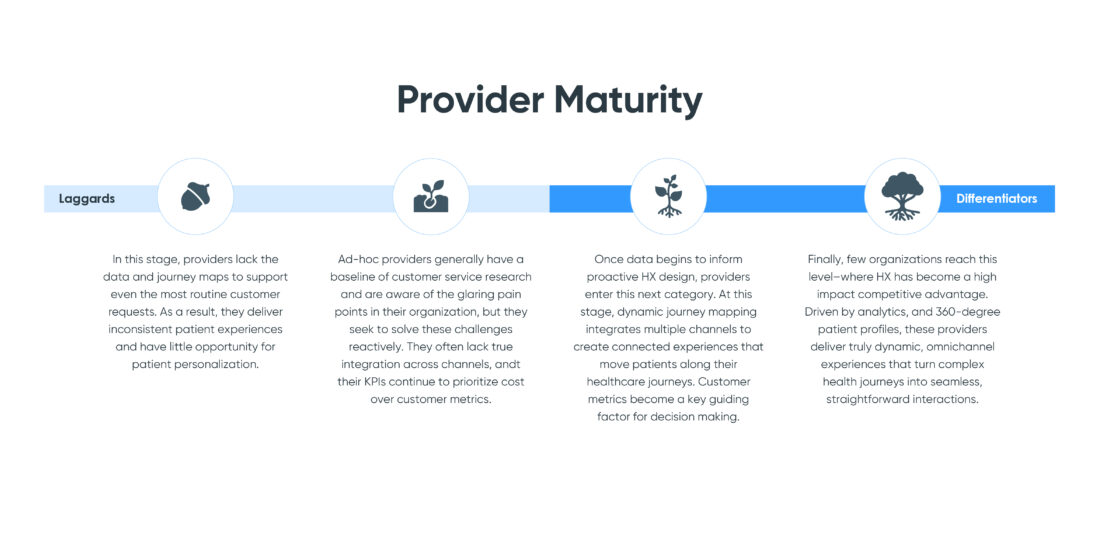Join our mailing list
Receive exclusive updates on the latest CX trends, events,
and solutions.
No items found.
Improving health outcomes through next-gen patient care experiences

Healthcare is undergoing a transformation, driven by rising patient expectations and rapidly advancing technology. Today, patients expect seamless, personalized, and high-quality care experiences, and healthcare organizations are challenged to meet these expectations while improving clinical outcomes and efficiency. But delivering a truly exceptional patient experience isn’t just a matter of convenience—it directly impacts health outcomes, loyalty, and operational success.
Let’s explore how patient-centric approaches, data insights, and strategic design can enhance patient experiences at every stage of care.
Patient experience encompasses every interaction a patient has with a healthcare system — from making appointments to receiving care and communicating with providers.
Historically, patients had only a few touchpoints with their providers. They would see their care team in-person during health appointments, interface with support and appointment scheduling staff, or call to get in touch with a clinician to answer their questions.
Over the past decade, however, this relatively limited list of potential healthcare touchpoints has expanded rapidly to include new digital tools and greater communication flexibility than ever before.

While these advancements carry significant promise to elevate engagement strategies and maximize care team bandwidth, they also create new opportunities to make or break patient perception of your organization, your culture, and even your competence as a provider.
Each interaction — whether online, on the phone, or in person — is only one small part of the overall patient experience. In practice, patient experiences are more commonly judged holistically by the relative ease with which patients can move between these interactions as they progress along their unique health journey.
Unlike patient satisfaction, which measures how content a patient feels, patient experience is about the quality of care at each stage. According to a survey by The Beryl Institute, 71% of patients believe healthcare systems should prioritize their experiences, viewing it as central to quality care.
For years, patient perceptions of care quality were undervalued in healthcare administration. Clinics and hospitals primarily engaged patients based on the needs of clinicians, workflows, and revenue streams. This focus stemmed not from a lack of concern for patients but from treatment reimbursement models that prioritized the volume of procedures (fee-for-service) over health outcomes.
The passage of the Affordable Care Act (ACA) in 2010 brought significant changes, introducing a value-based care model that rewarded providers for delivering quality care—defined as improved patient outcomes, better population health, lower costs, and increased provider satisfaction. The latter has become crucial in payer reimbursement, as healthcare organizations now use metrics like the Consumer Assessment of Healthcare Providers and Systems (CAHPS) survey to guide patient-centered care.
Patient expectations are evolving as well. With 88% of patients researching reviews online, the era of high-deductible health plans means they have more financial stakes than ever. This consumerization of healthcare has led patients to strategically choose clinicians and providers, raising their expectations.
Add to the mix a plethora of powerful, frictionless customer experiences surrounding patients at every turn in their day-to-day lives, and it is no surprise that patient expectations are rising. Compared to their last best experience in retail or with a direct-to-consumer brand, patients are demanding more from their providers.
For healthcare organizations, the potential cost of a poor experience can have a disastrous effect on already razor-thin provider margins. A U.S. Healthcare Consumer Experience study found that 41% o=of young healthcare consumers would stop visiting their provider after a negative digital experience, with 20% having already switched for this reason. With new entrants like startups and retail-based clinics, providers cannot afford to lag.
Moreover, a positive patient experience is linked to better health outcomes, lower hospital readmissions, and higher satisfaction. According to the Agency for Healthcare Research and Quality (AHRQ), providers focused on patient experience see 17% fewer post-surgery complications and decreased readmissions. An Accenture study revealed that nearly 80% of patients would switch providers due to poor experiences, highlighting the critical impact on patient retention.
Since COVID-19 disrupted many established patterns of care, most healthcare organizations can say they now check at least some of the digital boxes in a patient’s provider expectations checklist.
But these piecemeal executions of next-gen patient experience can’t live in a silo. They require seamless, strategic connectivity to every aspect of your healthcare operation — informed by data-driven insights — to drive truly transformational patient experiences that take your organization from ad-hoc patient experience strategies to embedded competitive advantages.

To move from left to right on this chart toward embedded status, here’s where organizations should focus their efforts:
{{cta-block-1}}
Understanding and optimizing patient experience requires more than anecdotal feedback; it requires data-driven insights. Here are some ways to turn data into action:
1. Collect patient feedback in real time
Studies indicate that responding to feedback within 24 hours can increase patient satisfaction by 25%, making it a key strategy in patient care.
Digital tools like tablet-based feedback stations, post-visit SMS surveys, and QR codes on hospital signage allow patients to share their experiences immediately. This real-time feedback enables staff to resolve issues while the patient is still in the facility, reducing the likelihood of complaints and increasing patient satisfaction.
For example, the Hospital Consumer Assessment of Healthcare Providers and Systems (HCAHPS) survey gathers structured insights into critical areas like provider communication and responsiveness, helping hospitals pinpoint specific areas needing improvement.
2. Analyze data trends and identify pain points
Aggregating and analyzing patient feedback along with clinical and operational data helps uncover trends that might not be visible through individual interactions alone.
For instance, if data reveals that patients frequently cite long wait times or inadequate follow-up care, organizations can prioritize these areas for immediate improvement. Some hospitals use dashboards that visually track these recurring issues, allowing administrators to spot patterns quickly and allocate resources where they’re needed most.
This data-driven approach ensures that improvements are targeted, impactful, and aligned with patient needs.
3. Use patient interviews and focus groups for deeper insights
While quantitative data provides a broad view, qualitative insights from patient interviews and focus groups can reveal the “why” behind patient feedback. These sessions allow healthcare providers to delve into specific experiences, uncovering emotional factors such as how supported and comfortable patients feel during their care.
For instance, if patients share that they felt rushed during consultations, staff training or additional scheduling changes might be needed. Such feedback informs tailored solutions that address not only clinical but also emotional well-being, ultimately enhancing the holistic patient experience.
4. Apply predictive analytics to anticipate patient needs
Predictive analytics helps providers anticipate and personalize patient care. For example, by analyzing a patient’s history and risk factors, providers can identify those at higher risk for readmission and proactively engage them with follow-up calls, personalized care plans, or reminders for preventative screenings.
This shift to proactive care — like notifying a diabetic patient of preventative foot screenings based on analytics — can improve health outcomes and boost patient satisfaction. Such personalized care interventions demonstrate a commitment to patients' health, enhancing their experience and trust in their healthcare provider.
Wondering what it looks like when an organization finally achieves a truly embedded patient experience strategy? While the results will vary based on the unique value propositions each organization seeks to provide, many of the best examples start by seeking solutions to key patient pain points and linking them to critical business initiatives.
Let’s look at two examples of organizations that got it right:
Mary Washington Healthcare is a large not-for-profit healthcare system with multiple hospitals and more than 50 healthcare facilities and wellness services. To deliver next-gen patient engagement, Mary Washington knew they needed to move away from analog approaches like TV and print and instead capitalize on the power of personalized digital experiences. They also knew they weren’t fully leveraging the wealth of data resources they had at their disposal to target patients with high-risk and chronic conditions and make decisions about the appropriate engagement strategies for each patient.
By partnering with TTEC Digital to help design and orchestrate a modern digital strategy, Mary Washington can unify and enrich disparate data from Epic and other data sources that will allow them to better engage selected patients with solutions that fit their patients’ digital expectations.
DispatchHealth’s big idea for patient care was simple: not every healthcare condition should require scheduling an in-person appointment or a frantic rush to the emergency room. Particularly, they saw a gap in care for patients with conditions who may face major challenges or additional health risks when trying to come in for an appointment at a clinic or hospital. These in-person visits also incurred higher costs—often beyond what was medically necessary to treat many routine ailments and illnesses. To help remove this major friction point, DispatchHealth wanted to design a way to make healthcare more mobile.
TTEC Digital helped DispatchHealth set up a hospital-at-home program where care is delivered in a patient’s home. Now, patients easily request care via a simple mobile or online request portal. On the back end, patient care teams assess each patient’s situation, and a real-time communication platform helps dispatch a qualified care team to treat each medical condition at home. As a result, this new care delivery model allows DispatchHealth to save an average of $6,200 per patient in unnecessary hospital and clinic costs while creating valuable peace of mind for overburdened patient populations.
Patients today have more choices than ever, and they won’t hesitate to switch providers if their needs aren’t met.
At TTEC Digital, we help healthcare organizations craft patient-centered experiences through data insights, seamless digital solutions, and strategic design. By focusing on each stage of the patient journey, we ensure that every interaction adds value and builds trust.
With expertise in journey mapping, technology integration, and patient feedback analysis, TTEC Digital empowers healthcare providers to optimize each step in the patient journey — from the initial online inquiry to post-care follow-up. Our solutions don’t just meet expectations; they exceed them by transforming healthcare into a truly patient-centric experience.
Get CX thought leadership right in your inbox.
See how intelligent automation can help you improve patient experiences and outcomes.